Ingest gridded products such as ice velocity into OGGM#
After running our OGGM experiments we often want to compare the model output to other gridded observations or maybe we want to use additional data sets that are not currently in the OGGM shop to calibrate parameters in the model (e.g. Glen A creep parameter, sliding parameter or the calving constant of proportionality). If you are looking on ways or ideas on how to do this, you are in the right tutorial!
In OGGM, a local map projection is defined for each glacier entity in the RGI inventory following the methods described in Maussion and others (2019). The model uses a Transverse Mercator projection centred on the glacier. A lot of data sets, especially those from Polar regions can have a different projections and if we are not careful, we would be making mistakes when we compare them with our model output or when we use such data sets to constrain our model experiments.
New in OGGM 1.6! We now offer preprocess directories where the data is available already. Visit OGGM as an accelerator for modelling and machine learning for more info.
First lets import the modules we need:
import xarray as xr
import numpy as np
import matplotlib.pyplot as plt
import salem
from oggm import cfg, utils, workflow, tasks, graphics
cfg.initialize(logging_level='WARNING')
2025-06-05 12:46:34: oggm.cfg: Reading default parameters from the OGGM `params.cfg` configuration file.
2025-06-05 12:46:34: oggm.cfg: Multiprocessing switched OFF according to the parameter file.
2025-06-05 12:46:34: oggm.cfg: Multiprocessing: using all available processors (N=4)
cfg.PATHS['working_dir'] = utils.gettempdir(dirname='OGGM-shop-on-Flowlines', reset=True)
Lets define the glaciers for the run#
rgi_ids = ['RGI60-14.06794'] # Baltoro
# The RGI version to use
# Size of the map around the glacier.
prepro_border = 80
# Degree of processing level. This is OGGM specific and for the shop 1 is the one you want
from_prepro_level = 3
# URL of the preprocessed gdirs
# we use elevation bands flowlines here
base_url = 'https://cluster.klima.uni-bremen.de/~oggm/gdirs/oggm_v1.6/L3-L5_files/2023.3/elev_bands/W5E5'
gdirs = workflow.init_glacier_directories(rgi_ids,
from_prepro_level=from_prepro_level,
prepro_base_url=base_url,
prepro_border=prepro_border)
2025-06-05 12:46:35: oggm.workflow: init_glacier_directories from prepro level 3 on 1 glaciers.
2025-06-05 12:46:35: oggm.workflow: Execute entity tasks [gdir_from_prepro] on 1 glaciers
gdir = gdirs[0]
graphics.plot_googlemap(gdir, figsize=(8, 7))
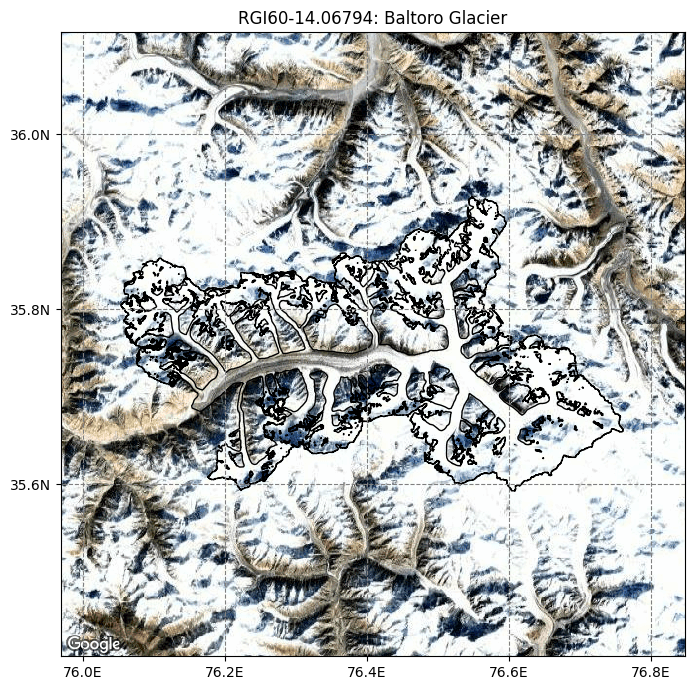
The gridded_data file in the glacier directory#
A lot of the data that the model use and produce for a glacier is stored under the glaciers directories in a NetCDF file called gridded_data:
fpath = gdir.get_filepath('gridded_data')
fpath
'/tmp/OGGM/OGGM-shop-on-Flowlines/per_glacier/RGI60-14/RGI60-14.06/RGI60-14.06794/gridded_data.nc'
with xr.open_dataset(fpath) as ds:
ds = ds.load()
ds
<xarray.Dataset> Size: 2MB
Dimensions: (x: 479, y: 346)
Coordinates:
* x (x) float32 2kB -4.764e+04 -4.744e+04 ... 4.796e+04
* y (y) float32 1kB 3.992e+06 3.992e+06 ... 3.923e+06 3.923e+06
Data variables:
topo (y, x) float32 663kB 5.128e+03 4.999e+03 ... 5.3e+03
topo_smoothed (y, x) float32 663kB 5.113e+03 5.019e+03 ... 5.296e+03
topo_valid_mask (y, x) int8 166kB 1 1 1 1 1 1 1 1 1 1 ... 1 1 1 1 1 1 1 1 1
glacier_mask (y, x) int8 166kB 0 0 0 0 0 0 0 0 0 0 ... 0 0 0 0 0 0 0 0 0
glacier_ext (y, x) int8 166kB 0 0 0 0 0 0 0 0 0 0 ... 0 0 0 0 0 0 0 0 0
Attributes:
author: OGGM
author_info: Open Global Glacier Model
pyproj_srs: +proj=tmerc +lat_0=0 +lon_0=76.4047 +k=0.9996 +x_0=0 +y_0...
max_h_dem: 8437.0
min_h_dem: 2996.0
max_h_glacier: 8437.0
min_h_glacier: 3397.0cmap=salem.get_cmap('topo')
ds.topo.plot(figsize=(7, 4), cmap=cmap);
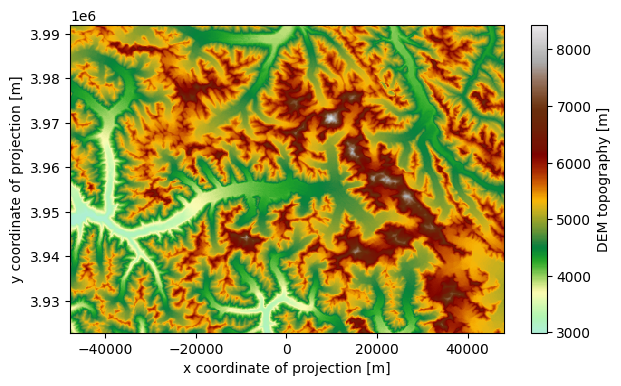
ds.glacier_mask.plot();
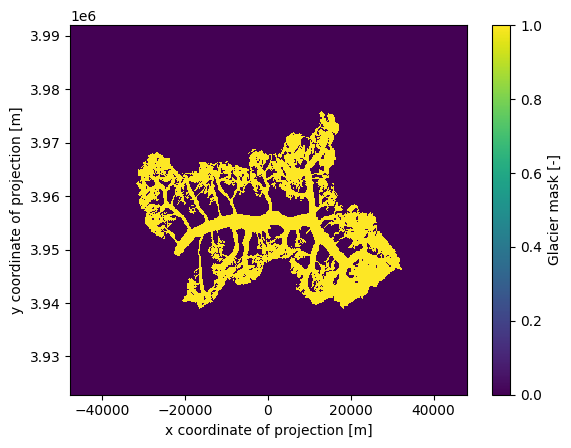
Merging the gridded_data files of multiple glacier directories#
It is also possible to merge the gridded_data files of multiple glacier directories. Let’s try it with two glaciers:
rgi_ids_for_merge = ['RGI60-14.06794', # Baltoro
'RGI60-14.07524', # Siachen
]
gdirs_for_merge = workflow.init_glacier_directories(rgi_ids_for_merge,
from_prepro_level=from_prepro_level,
prepro_base_url=base_url,
prepro_border=prepro_border)
2025-06-05 12:46:44: oggm.workflow: init_glacier_directories from prepro level 3 on 2 glaciers.
2025-06-05 12:46:44: oggm.workflow: Execute entity tasks [gdir_from_prepro] on 2 glaciers
ds_merged = workflow.merge_gridded_data(
gdirs_for_merge,
output_folder=None, # by default the final file is saved at cfg.PATHS['working_dir']
output_filename='gridded_data_merged', # the default file is saved as gridded_data_merged.nc
included_variables='all', # you also can provide a list of variables here
add_topography=False, # here we can add topography for the new extend
reset=False, # set to True if you want to overwrite an already existing file (for playing around)
)
2025-06-05 12:46:55: oggm.workflow: Applying global task merge_gridded_data on 2 glaciers
2025-06-05 12:46:55: oggm.workflow: Execute entity tasks [reproject_gridded_data_variable_to_grid] on 2 glaciers
2025-06-05 12:46:56: oggm.workflow: Execute entity tasks [reproject_gridded_data_variable_to_grid] on 2 glaciers
ds_merged
<xarray.Dataset> Size: 3MB
Dimensions: (x: 744, y: 582)
Coordinates:
* x (x) float32 3kB -4.774e+04 -4.754e+04 ... 1.007e+05 1.009e+05
* y (y) float32 2kB 3.992e+06 3.992e+06 ... 3.876e+06 3.876e+06
Data variables:
glacier_mask (y, x) float32 2MB 0.0 0.0 0.0 0.0 0.0 ... 0.0 0.0 0.0 0.0 0.0
glacier_ext (y, x) float32 2MB 0.0 0.0 0.0 0.0 0.0 ... 0.0 0.0 0.0 0.0 0.0
Attributes:
author: OGGM
author_info: Open Global Glacier Model
pyproj_srs: +proj=tmerc +lat_0=0 +lon_0=76.4047 +k=0.9996 +x_...
nr_of_merged_glaciers: 2
rgi_ids: ['RGI60-14.06794', 'RGI60-14.07524']ds_merged.glacier_mask.plot()
<matplotlib.collections.QuadMesh at 0x7f8d4e168990>
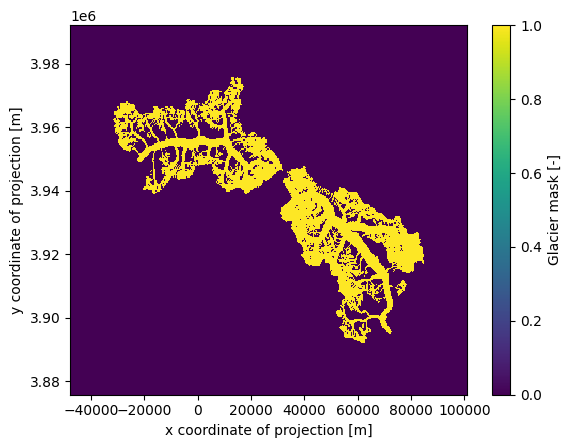
As you can see, topography is not included because this process requires some time. The reason is that topography is not simply reprojected from the existing gridded_data; instead, it is redownloaded from the source and processed for the new ‘merged extent’. You can include topography by setting add_topography=True or specifying the DEM source add_topography='dem_source'.
There are additional options available, such as use_glacier_mask or preserve_totals (for preserving the total volume when merging distributed thickness data). For a more comprehensive explanation of these options, refer to the Docstring (by uncommenting the line below).
# for more available options uncomment the following line
# workflow.merge_gridded_data?
Add data from OGGM-Shop: bed topography data#
Additionally to the data produced by the model, the OGGM-Shop counts with routines that will automatically download and reproject other useful data sets into the glacier projection (For more information also check out this notebook). This data will be stored under the file described above.
OGGM can now download data from the Farinotti et al., (2019) consensus estimate and reproject it to the glacier directories map:
from oggm.shop import bedtopo
workflow.execute_entity_task(bedtopo.add_consensus_thickness, gdirs);
2025-06-05 12:46:56: oggm.workflow: Execute entity tasks [add_consensus_thickness] on 1 glaciers
with xr.open_dataset(gdir.get_filepath('gridded_data')) as ds:
ds = ds.load()
the cell below might take a while… be patient
# plot the salem map background, make countries in grey
smap = ds.salem.get_map(countries=False)
smap.set_shapefile(gdir.read_shapefile('outlines'))
smap.set_topography(ds.topo.data);
f, ax = plt.subplots(figsize=(9, 9))
smap.set_data(ds.consensus_ice_thickness)
smap.set_cmap('Blues')
smap.plot(ax=ax)
smap.append_colorbar(ax=ax, label='ice thickness (m)');
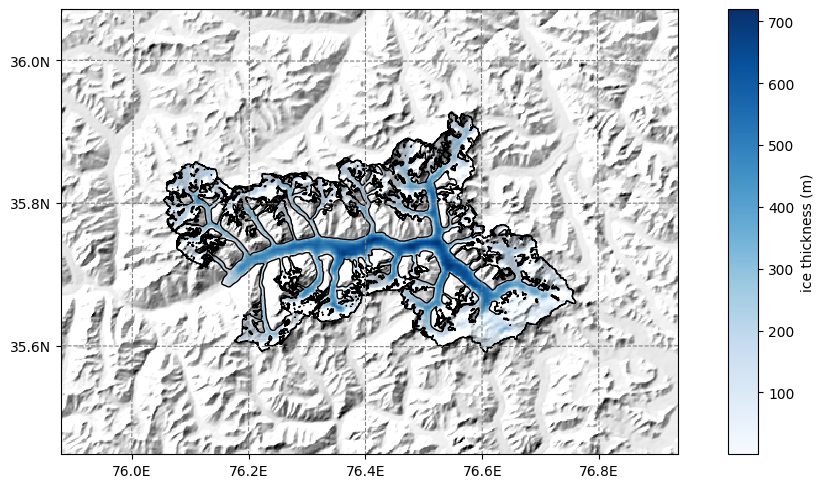
OGGM-Shop: velocities#
We download data from Millan 2022 (see the shop).
If you want more velocity products, feel free to open a new topic on the OGGM issue tracker!
this will download severals large datasets depending on your connection, it might take some time …
# attention downloads data!!!
from oggm.shop import millan22
workflow.execute_entity_task(millan22.velocity_to_gdir, gdirs);
---------------------------------------------------------------------------
AttributeError Traceback (most recent call last)
Cell In[23], line 3
1 # attention downloads data!!!
2 from oggm.shop import millan22
----> 3 workflow.execute_entity_task(millan22.velocity_to_gdir, gdirs);
AttributeError: module 'oggm.shop.millan22' has no attribute 'velocity_to_gdir'
By applying the entity task velocity to gdir OGGM downloads and reprojects the ITS_live files to a given glacier map.
The velocity components (vx, vy) are added to the gridded_data nc file.
Now we can read in all the gridded data that comes with OGGM, including the velocity components.
with xr.open_dataset(gdir.get_filepath('gridded_data')) as ds:
ds = ds.load()
ds
<xarray.Dataset> Size: 2MB
Dimensions: (x: 479, y: 346)
Coordinates:
* x (x) float32 2kB -4.764e+04 -4.744e+04 ... 4.796e+04
* y (y) float32 1kB 3.992e+06 3.992e+06 ... 3.923e+06
Data variables:
topo (y, x) float32 663kB 5.128e+03 ... 5.3e+03
topo_smoothed (y, x) float32 663kB 5.113e+03 ... 5.296e+03
topo_valid_mask (y, x) int8 166kB 1 1 1 1 1 1 1 1 ... 1 1 1 1 1 1 1
glacier_mask (y, x) int8 166kB 0 0 0 0 0 0 0 0 ... 0 0 0 0 0 0 0
glacier_ext (y, x) int8 166kB 0 0 0 0 0 0 0 0 ... 0 0 0 0 0 0 0
consensus_ice_thickness (y, x) float32 663kB nan nan nan ... nan nan nan
Attributes:
author: OGGM
author_info: Open Global Glacier Model
pyproj_srs: +proj=tmerc +lat_0=0 +lon_0=76.4047 +k=0.9996 +x_0=0 +y_0...
max_h_dem: 8437.0
min_h_dem: 2996.0
max_h_glacier: 8437.0
min_h_glacier: 3397.0# plot the salem map background, make countries in grey
smap = ds.salem.get_map(countries=False)
smap.set_shapefile(gdir.read_shapefile('outlines'))
smap.set_topography(ds.topo.data);
ds
<xarray.Dataset> Size: 2MB
Dimensions: (x: 479, y: 346)
Coordinates:
* x (x) float32 2kB -4.764e+04 -4.744e+04 ... 4.796e+04
* y (y) float32 1kB 3.992e+06 3.992e+06 ... 3.923e+06
Data variables:
topo (y, x) float32 663kB 5.128e+03 ... 5.3e+03
topo_smoothed (y, x) float32 663kB 5.113e+03 ... 5.296e+03
topo_valid_mask (y, x) int8 166kB 1 1 1 1 1 1 1 1 ... 1 1 1 1 1 1 1
glacier_mask (y, x) int8 166kB 0 0 0 0 0 0 0 0 ... 0 0 0 0 0 0 0
glacier_ext (y, x) int8 166kB 0 0 0 0 0 0 0 0 ... 0 0 0 0 0 0 0
consensus_ice_thickness (y, x) float32 663kB nan nan nan ... nan nan nan
Attributes:
author: OGGM
author_info: Open Global Glacier Model
pyproj_srs: +proj=tmerc +lat_0=0 +lon_0=76.4047 +k=0.9996 +x_0=0 +y_0...
max_h_dem: 8437.0
min_h_dem: 2996.0
max_h_glacier: 8437.0
min_h_glacier: 3397.0# get the velocity data
u = ds.millan_vx.where(ds.glacier_mask)
v = ds.millan_vy.where(ds.glacier_mask)
ws = (u**2 + v**2)**0.5
---------------------------------------------------------------------------
AttributeError Traceback (most recent call last)
Cell In[27], line 2
1 # get the velocity data
----> 2 u = ds.millan_vx.where(ds.glacier_mask)
3 v = ds.millan_vy.where(ds.glacier_mask)
4 ws = (u**2 + v**2)**0.5
File /usr/local/pyenv/versions/3.11.11/lib/python3.11/site-packages/xarray/core/common.py:305, in AttrAccessMixin.__getattr__(self, name)
303 with suppress(KeyError):
304 return source[name]
--> 305 raise AttributeError(
306 f"{type(self).__name__!r} object has no attribute {name!r}"
307 )
AttributeError: 'Dataset' object has no attribute 'millan_vx'
The .where(ds.glacier_mask) command will remove the data outside of the glacier outline.
# get the axes ready
f, ax = plt.subplots(figsize=(12, 12))
# Quiver only every 3rd grid point
us = u[1::5, 1::5]
vs = v[1::5, 1::5]
smap.set_data(ws)
smap.set_cmap('Blues')
smap.plot(ax=ax)
smap.append_colorbar(ax=ax, label = 'ice velocity (m yr$^{-1}$)')
# transform their coordinates to the map reference system and plot the arrows
xx, yy = smap.grid.transform(us.x.values, us.y.values, crs=gdir.grid.proj)
xx, yy = np.meshgrid(xx, yy)
qu = ax.quiver(xx, yy, us.values, vs.values)
qk = ax.quiverkey(qu, 0.82, 0.97, 200, '200 m yr$^{-1}$',
labelpos='E', coordinates='axes')
---------------------------------------------------------------------------
NameError Traceback (most recent call last)
Cell In[28], line 5
2 f, ax = plt.subplots(figsize=(12, 12))
4 # Quiver only every 3rd grid point
----> 5 us = u[1::5, 1::5]
6 vs = v[1::5, 1::5]
8 smap.set_data(ws)
NameError: name 'u' is not defined
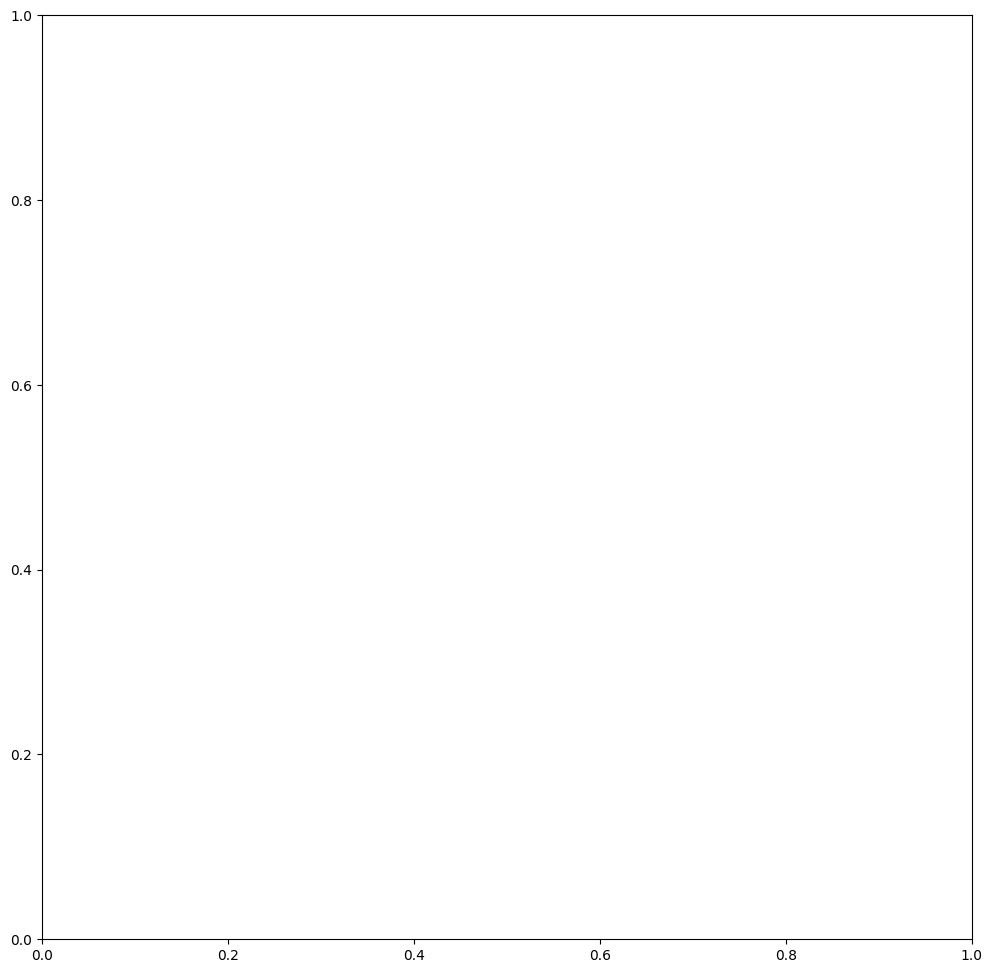
Bin the data in gridded_data into OGGM elevation bands#
Now that we have added new data to the gridded_data file, we can bin the data sets into the same elevation bands as OGGM by recomputing the elevation bands flowlines:
tasks.elevation_band_flowline(gdir,
bin_variables=['consensus_ice_thickness',
'millan_vx',
'millan_vy'],
preserve_totals=[True, False, False] # I"m actually not sure if preserving totals is meaningful with velocities - likely not
# NOTE: we could bin variables according to max() as well!
)
2025-06-05 12:47:16: oggm.core.centerlines: RGI60-14.06794: var `millan_vx` not found in gridded_data.
2025-06-05 12:47:16: oggm.core.centerlines: RGI60-14.06794: var `millan_vy` not found in gridded_data.
2025-06-05 12:47:16: oggm.core.centerlines: ValueError occurred during task elevation_band_flowline on RGI60-14.06794: Cannot broadcast len 3 to desired length: 1.
---------------------------------------------------------------------------
ValueError Traceback (most recent call last)
Cell In[29], line 1
----> 1 tasks.elevation_band_flowline(gdir,
2 bin_variables=['consensus_ice_thickness',
3 'millan_vx',
4 'millan_vy'],
5 preserve_totals=[True, False, False] # I"m actually not sure if preserving totals is meaningful with velocities - likely not
6 # NOTE: we could bin variables according to max() as well!
7 )
File /usr/local/pyenv/versions/3.11.11/lib/python3.11/site-packages/oggm/utils/_workflow.py:496, in entity_task.__call__.<locals>._entity_task(gdir, reset, print_log, return_value, continue_on_error, add_to_log_file, **kwargs)
494 signal.alarm(cfg.PARAMS['task_timeout'])
495 ex_t = time.time()
--> 496 out = task_func(gdir, **kwargs)
497 ex_t = time.time() - ex_t
498 if cfg.PARAMS['task_timeout'] > 0:
File /usr/local/pyenv/versions/3.11.11/lib/python3.11/site-packages/oggm/core/centerlines.py:2239, in elevation_band_flowline(gdir, bin_variables, preserve_totals)
2236 out_totals.append(data_sum * gdir.grid.dx ** 2)
2237 out_vars.append(data[glacier_mask])
-> 2239 preserve_totals = utils.tolist(preserve_totals, length=len(bin_variables))
2241 # Slope
2242 sy, sx = np.gradient(topo, gdir.grid.dx)
File /usr/local/pyenv/versions/3.11.11/lib/python3.11/site-packages/oggm/utils/_funcs.py:169, in tolist(arg, length)
167 pass
168 else:
--> 169 raise ValueError('Cannot broadcast len {} '.format(len(arg)) +
170 'to desired length: {}.'.format(length))
172 return arg
ValueError: Cannot broadcast len 3 to desired length: 1.
This created a csv in the glacier directory folder with the data binned to it:
import pandas as pd
df = pd.read_csv(gdir.get_filepath('elevation_band_flowline'), index_col=0)
df
| area | mean_elevation | slope | bin_elevation | dx | width | |
|---|---|---|---|---|---|---|
| dis_along_flowline | ||||||
| 60.171679 | 40000.0 | 8345.080078 | 0.244307 | 8355.0 | 120.343358 | 332.382282 |
| 140.402840 | 80000.0 | 8235.237305 | 0.642076 | 8235.0 | 40.118964 | 1994.069438 |
| 173.939057 | 40000.0 | 8197.490234 | 0.838839 | 8205.0 | 26.953469 | 1484.039045 |
| 202.715848 | 40000.0 | 8150.462402 | 0.775496 | 8145.0 | 30.600113 | 1307.184709 |
| 236.362148 | 40000.0 | 8075.439453 | 0.685385 | 8085.0 | 36.692489 | 1090.141376 |
| ... | ... | ... | ... | ... | ... | ... |
| 42309.175061 | 760000.0 | 3525.279541 | 0.104130 | 3525.0 | 287.058303 | 2647.545781 |
| 42584.145386 | 400000.0 | 3495.227295 | 0.113628 | 3495.0 | 262.882346 | 1521.593236 |
| 42815.229714 | 200000.0 | 3472.789551 | 0.149415 | 3465.0 | 199.286311 | 1003.581227 |
| 43010.617627 | 200000.0 | 3441.432861 | 0.155403 | 3435.0 | 191.489514 | 1044.443613 |
| 43225.272023 | 120000.0 | 3407.177490 | 0.125483 | 3405.0 | 237.819278 | 504.584831 |
157 rows × 6 columns
df['obs_velocity'] = (df['millan_vx']**2 + df['millan_vy']**2)**0.5
df['bed_h'] = df['mean_elevation'] - df['consensus_ice_thickness']
---------------------------------------------------------------------------
KeyError Traceback (most recent call last)
File /usr/local/pyenv/versions/3.11.11/lib/python3.11/site-packages/pandas/core/indexes/base.py:3805, in Index.get_loc(self, key)
3804 try:
-> 3805 return self._engine.get_loc(casted_key)
3806 except KeyError as err:
File index.pyx:167, in pandas._libs.index.IndexEngine.get_loc()
File index.pyx:196, in pandas._libs.index.IndexEngine.get_loc()
File pandas/_libs/hashtable_class_helper.pxi:7081, in pandas._libs.hashtable.PyObjectHashTable.get_item()
File pandas/_libs/hashtable_class_helper.pxi:7089, in pandas._libs.hashtable.PyObjectHashTable.get_item()
KeyError: 'millan_vx'
The above exception was the direct cause of the following exception:
KeyError Traceback (most recent call last)
Cell In[31], line 1
----> 1 df['obs_velocity'] = (df['millan_vx']**2 + df['millan_vy']**2)**0.5
2 df['bed_h'] = df['mean_elevation'] - df['consensus_ice_thickness']
File /usr/local/pyenv/versions/3.11.11/lib/python3.11/site-packages/pandas/core/frame.py:4102, in DataFrame.__getitem__(self, key)
4100 if self.columns.nlevels > 1:
4101 return self._getitem_multilevel(key)
-> 4102 indexer = self.columns.get_loc(key)
4103 if is_integer(indexer):
4104 indexer = [indexer]
File /usr/local/pyenv/versions/3.11.11/lib/python3.11/site-packages/pandas/core/indexes/base.py:3812, in Index.get_loc(self, key)
3807 if isinstance(casted_key, slice) or (
3808 isinstance(casted_key, abc.Iterable)
3809 and any(isinstance(x, slice) for x in casted_key)
3810 ):
3811 raise InvalidIndexError(key)
-> 3812 raise KeyError(key) from err
3813 except TypeError:
3814 # If we have a listlike key, _check_indexing_error will raise
3815 # InvalidIndexError. Otherwise we fall through and re-raise
3816 # the TypeError.
3817 self._check_indexing_error(key)
KeyError: 'millan_vx'
df[['mean_elevation', 'bed_h', 'obs_velocity']].plot(figsize=(10, 4), secondary_y='obs_velocity');
---------------------------------------------------------------------------
KeyError Traceback (most recent call last)
Cell In[32], line 1
----> 1 df[['mean_elevation', 'bed_h', 'obs_velocity']].plot(figsize=(10, 4), secondary_y='obs_velocity');
File /usr/local/pyenv/versions/3.11.11/lib/python3.11/site-packages/pandas/core/frame.py:4108, in DataFrame.__getitem__(self, key)
4106 if is_iterator(key):
4107 key = list(key)
-> 4108 indexer = self.columns._get_indexer_strict(key, "columns")[1]
4110 # take() does not accept boolean indexers
4111 if getattr(indexer, "dtype", None) == bool:
File /usr/local/pyenv/versions/3.11.11/lib/python3.11/site-packages/pandas/core/indexes/base.py:6200, in Index._get_indexer_strict(self, key, axis_name)
6197 else:
6198 keyarr, indexer, new_indexer = self._reindex_non_unique(keyarr)
-> 6200 self._raise_if_missing(keyarr, indexer, axis_name)
6202 keyarr = self.take(indexer)
6203 if isinstance(key, Index):
6204 # GH 42790 - Preserve name from an Index
File /usr/local/pyenv/versions/3.11.11/lib/python3.11/site-packages/pandas/core/indexes/base.py:6252, in Index._raise_if_missing(self, key, indexer, axis_name)
6249 raise KeyError(f"None of [{key}] are in the [{axis_name}]")
6251 not_found = list(ensure_index(key)[missing_mask.nonzero()[0]].unique())
-> 6252 raise KeyError(f"{not_found} not in index")
KeyError: "['bed_h', 'obs_velocity'] not in index"
The problem with this file is that it does not have a regular spacing. The numerical model needs regular spacing, which is why OGGM does this:
# This takes the csv file and prepares new 'inversion_flowlines.pkl' and created a new csv file with regular spacing
tasks.fixed_dx_elevation_band_flowline(gdir,
bin_variables=['consensus_ice_thickness',
'millan_vx',
'millan_vy'],
preserve_totals=[True, False, False]
)
2025-06-05 12:47:17: oggm.core.centerlines: RGI60-14.06794: var `consensus_ice_thickness` not found in gridded_data.
2025-06-05 12:47:17: oggm.core.centerlines: RGI60-14.06794: var `millan_vx` not found in gridded_data.
2025-06-05 12:47:17: oggm.core.centerlines: RGI60-14.06794: var `millan_vy` not found in gridded_data.
2025-06-05 12:47:17: oggm.core.centerlines: ValueError occurred during task fixed_dx_elevation_band_flowline on RGI60-14.06794: Cannot broadcast len 3 to desired length: 0.
---------------------------------------------------------------------------
ValueError Traceback (most recent call last)
Cell In[33], line 2
1 # This takes the csv file and prepares new 'inversion_flowlines.pkl' and created a new csv file with regular spacing
----> 2 tasks.fixed_dx_elevation_band_flowline(gdir,
3 bin_variables=['consensus_ice_thickness',
4 'millan_vx',
5 'millan_vy'],
6 preserve_totals=[True, False, False]
7 )
File /usr/local/pyenv/versions/3.11.11/lib/python3.11/site-packages/oggm/utils/_workflow.py:496, in entity_task.__call__.<locals>._entity_task(gdir, reset, print_log, return_value, continue_on_error, add_to_log_file, **kwargs)
494 signal.alarm(cfg.PARAMS['task_timeout'])
495 ex_t = time.time()
--> 496 out = task_func(gdir, **kwargs)
497 ex_t = time.time() - ex_t
498 if cfg.PARAMS['task_timeout'] > 0:
File /usr/local/pyenv/versions/3.11.11/lib/python3.11/site-packages/oggm/core/centerlines.py:2418, in fixed_dx_elevation_band_flowline(gdir, bin_variables, preserve_totals)
2414 log.warning('{}: var `{}` not found in gridded_data.'
2415 ''.format(gdir.rgi_id, var))
2416 bin_variables = keep
-> 2418 preserve_totals = utils.tolist(preserve_totals,
2419 length=len(bin_variables))
2420 odf = pd.DataFrame(index=dis_along_flowline)
2421 odf.index.name = 'dis_along_flowline'
File /usr/local/pyenv/versions/3.11.11/lib/python3.11/site-packages/oggm/utils/_funcs.py:169, in tolist(arg, length)
167 pass
168 else:
--> 169 raise ValueError('Cannot broadcast len {} '.format(len(arg)) +
170 'to desired length: {}.'.format(length))
172 return arg
ValueError: Cannot broadcast len 3 to desired length: 0.
df_regular = pd.read_csv(gdir.get_filepath('elevation_band_flowline', filesuffix='_fixed_dx'), index_col=0)
df_regular
---------------------------------------------------------------------------
FileNotFoundError Traceback (most recent call last)
Cell In[34], line 1
----> 1 df_regular = pd.read_csv(gdir.get_filepath('elevation_band_flowline', filesuffix='_fixed_dx'), index_col=0)
2 df_regular
File /usr/local/pyenv/versions/3.11.11/lib/python3.11/site-packages/pandas/io/parsers/readers.py:1026, in read_csv(filepath_or_buffer, sep, delimiter, header, names, index_col, usecols, dtype, engine, converters, true_values, false_values, skipinitialspace, skiprows, skipfooter, nrows, na_values, keep_default_na, na_filter, verbose, skip_blank_lines, parse_dates, infer_datetime_format, keep_date_col, date_parser, date_format, dayfirst, cache_dates, iterator, chunksize, compression, thousands, decimal, lineterminator, quotechar, quoting, doublequote, escapechar, comment, encoding, encoding_errors, dialect, on_bad_lines, delim_whitespace, low_memory, memory_map, float_precision, storage_options, dtype_backend)
1013 kwds_defaults = _refine_defaults_read(
1014 dialect,
1015 delimiter,
(...) 1022 dtype_backend=dtype_backend,
1023 )
1024 kwds.update(kwds_defaults)
-> 1026 return _read(filepath_or_buffer, kwds)
File /usr/local/pyenv/versions/3.11.11/lib/python3.11/site-packages/pandas/io/parsers/readers.py:620, in _read(filepath_or_buffer, kwds)
617 _validate_names(kwds.get("names", None))
619 # Create the parser.
--> 620 parser = TextFileReader(filepath_or_buffer, **kwds)
622 if chunksize or iterator:
623 return parser
File /usr/local/pyenv/versions/3.11.11/lib/python3.11/site-packages/pandas/io/parsers/readers.py:1620, in TextFileReader.__init__(self, f, engine, **kwds)
1617 self.options["has_index_names"] = kwds["has_index_names"]
1619 self.handles: IOHandles | None = None
-> 1620 self._engine = self._make_engine(f, self.engine)
File /usr/local/pyenv/versions/3.11.11/lib/python3.11/site-packages/pandas/io/parsers/readers.py:1880, in TextFileReader._make_engine(self, f, engine)
1878 if "b" not in mode:
1879 mode += "b"
-> 1880 self.handles = get_handle(
1881 f,
1882 mode,
1883 encoding=self.options.get("encoding", None),
1884 compression=self.options.get("compression", None),
1885 memory_map=self.options.get("memory_map", False),
1886 is_text=is_text,
1887 errors=self.options.get("encoding_errors", "strict"),
1888 storage_options=self.options.get("storage_options", None),
1889 )
1890 assert self.handles is not None
1891 f = self.handles.handle
File /usr/local/pyenv/versions/3.11.11/lib/python3.11/site-packages/pandas/io/common.py:873, in get_handle(path_or_buf, mode, encoding, compression, memory_map, is_text, errors, storage_options)
868 elif isinstance(handle, str):
869 # Check whether the filename is to be opened in binary mode.
870 # Binary mode does not support 'encoding' and 'newline'.
871 if ioargs.encoding and "b" not in ioargs.mode:
872 # Encoding
--> 873 handle = open(
874 handle,
875 ioargs.mode,
876 encoding=ioargs.encoding,
877 errors=errors,
878 newline="",
879 )
880 else:
881 # Binary mode
882 handle = open(handle, ioargs.mode)
FileNotFoundError: [Errno 2] No such file or directory: '/tmp/OGGM/OGGM-shop-on-Flowlines/per_glacier/RGI60-14/RGI60-14.06/RGI60-14.06794/elevation_band_flowline_fixed_dx.csv'
The other variables have disappeared for saving space, but I think it would be nicer to have them here as well. We can grab them from the inversion flowlines (this could be better handled in OGGM):
fl = gdir.read_pickle('inversion_flowlines')[0]
df_regular['mean_elevation'] = fl.surface_h
---------------------------------------------------------------------------
NameError Traceback (most recent call last)
Cell In[35], line 2
1 fl = gdir.read_pickle('inversion_flowlines')[0]
----> 2 df_regular['mean_elevation'] = fl.surface_h
NameError: name 'df_regular' is not defined
df_regular['obs_velocity'] = (df_regular['millan_vx']**2 + df_regular['millan_vy']**2)**0.5
df_regular['consensus_bed_h'] = df_regular['mean_elevation'] - df_regular['consensus_ice_thickness']
---------------------------------------------------------------------------
NameError Traceback (most recent call last)
Cell In[36], line 1
----> 1 df_regular['obs_velocity'] = (df_regular['millan_vx']**2 + df_regular['millan_vy']**2)**0.5
2 df_regular['consensus_bed_h'] = df_regular['mean_elevation'] - df_regular['consensus_ice_thickness']
NameError: name 'df_regular' is not defined
df_regular[['mean_elevation', 'consensus_bed_h', 'obs_velocity']].plot(figsize=(10, 4),
secondary_y='obs_velocity');
---------------------------------------------------------------------------
NameError Traceback (most recent call last)
Cell In[37], line 1
----> 1 df_regular[['mean_elevation', 'consensus_bed_h', 'obs_velocity']].plot(figsize=(10, 4),
2 secondary_y='obs_velocity');
NameError: name 'df_regular' is not defined
OK so more or less the same but this time on a regular grid. Note that these now have the same length as the OGGM inversion flowlines, i.e. one can do stuff such as comparing what OGGM has done for the inversion:
inv = gdir.read_pickle('inversion_output')[0]
df_regular['OGGM_bed'] = df_regular['mean_elevation'] - inv['thick']
---------------------------------------------------------------------------
NameError Traceback (most recent call last)
Cell In[39], line 1
----> 1 df_regular['OGGM_bed'] = df_regular['mean_elevation'] - inv['thick']
NameError: name 'df_regular' is not defined
df_regular[['mean_elevation', 'consensus_bed_h', 'OGGM_bed']].plot();
---------------------------------------------------------------------------
NameError Traceback (most recent call last)
Cell In[40], line 1
----> 1 df_regular[['mean_elevation', 'consensus_bed_h', 'OGGM_bed']].plot();
NameError: name 'df_regular' is not defined
Compare velocities: at inversion#
OGGM already inverted the ice thickness based on some optimisation such as matching the regional totals. Which parameters did we use?
d = gdir.get_diagnostics()
d
{'dem_source': 'NASADEM',
'flowline_type': 'elevation_band',
'apparent_mb_from_any_mb_residual': 56.10000000000032,
'inversion_glen_a': 6.42968271645714e-24,
'inversion_fs': 0}
# OK set them so that we are consistent
cfg.PARAMS['inversion_glen_a'] = d['inversion_glen_a']
cfg.PARAMS['inversion_fs'] = d['inversion_fs']
2025-06-05 12:47:17: oggm.cfg: PARAMS['inversion_glen_a'] changed from `2.4e-24` to `6.42968271645714e-24`.
# Since we overwrote the inversion flowlines we have to do stuff again
tasks.mb_calibration_from_geodetic_mb(gdir,
informed_threestep=True,
overwrite_gdir=True)
tasks.apparent_mb_from_any_mb(gdir)
tasks.prepare_for_inversion(gdir)
tasks.mass_conservation_inversion(gdir)
tasks.compute_inversion_velocities(gdir)
inv = gdir.read_pickle('inversion_output')[0]
df_regular['OGGM_inversion_velocity'] = inv['u_surface']
---------------------------------------------------------------------------
NameError Traceback (most recent call last)
Cell In[45], line 1
----> 1 df_regular['OGGM_inversion_velocity'] = inv['u_surface']
NameError: name 'df_regular' is not defined
df_regular[['obs_velocity', 'OGGM_inversion_velocity']].plot();
---------------------------------------------------------------------------
NameError Traceback (most recent call last)
Cell In[46], line 1
----> 1 df_regular[['obs_velocity', 'OGGM_inversion_velocity']].plot();
NameError: name 'df_regular' is not defined
The velocities are higher, because:
OGGM is at equilibrium
the comparison between the bulk velocities of OGGM and the gridded observed ones is not straightforward.
Velocities during the run#
TODO: here we could use velocities from the spinup run!!
Inversion velocities are for a glacier at equilibrium - this is not always meaningful. Lets do a run and store the velocities with time:
cfg.PARAMS['store_fl_diagnostics'] = True
2025-06-05 12:47:18: oggm.cfg: PARAMS['store_fl_diagnostics'] changed from `False` to `True`.
tasks.run_from_climate_data(gdir);
with xr.open_dataset(gdir.get_filepath('model_diagnostics')) as ds_diag:
ds_diag = ds_diag.load()
ds_diag.volume_m3.plot();
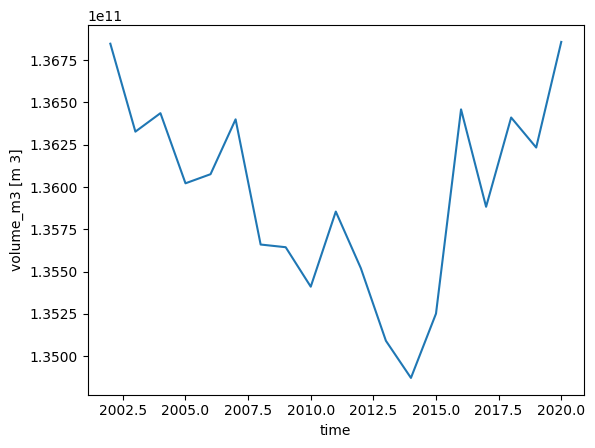
with xr.open_dataset(gdir.get_filepath('fl_diagnostics'), group='fl_0') as ds_fl:
ds_fl = ds_fl.load()
ds_fl
<xarray.Dataset> Size: 251kB
Dimensions: (dis_along_flowline: 179, time: 19)
Coordinates:
* dis_along_flowline (dis_along_flowline) float64 1kB 0.0 400.0 ... 7.12e+04
* time (time) float64 152B 2.002e+03 2.003e+03 ... 2.02e+03
Data variables: (12/13)
point_lons (dis_along_flowline) float64 1kB 75.88 75.88 ... 76.67
point_lats (dis_along_flowline) float64 1kB 36.07 36.07 ... 36.07
bed_h (dis_along_flowline) float64 1kB 8.131e+03 ... 3.007...
volume_m3 (time, dis_along_flowline) float64 27kB 1.28e+07 ......
volume_bsl_m3 (time, dis_along_flowline) float64 27kB 0.0 0.0 ... 0.0
volume_bwl_m3 (time, dis_along_flowline) float64 27kB 0.0 0.0 ... 0.0
... ...
thickness_m (time, dis_along_flowline) float64 27kB 24.12 ... 0.0
ice_velocity_myr (time, dis_along_flowline) float64 27kB nan nan ... 0.0
calving_bucket_m3 (time) float64 152B 0.0 0.0 0.0 0.0 ... 0.0 0.0 0.0 0.0
flux_divergence_myr (time, dis_along_flowline) float64 27kB nan nan ... 0.0
climatic_mb_myr (time, dis_along_flowline) float64 27kB nan nan ... 0.0
dhdt_myr (time, dis_along_flowline) float64 27kB nan nan ... 0.0
Attributes:
calendar: 365-day no leap
water_level: 0
dx: 2.0
creation_date: 2025-06-05 12:47:18
fs: 0
mb_model_class: MultipleFlowlineMassBalance
map_dx: 200.0
class: MixedBedFlowline
glen_a: 6.42968271645714e-24
oggm_version: 1.6.3.dev10+g24a25ac
mb_model_hemisphere: nh
description: OGGM model outputds_fl.sel(time=[2003, 2010, 2020]).ice_velocity_myr.plot(hue='time');
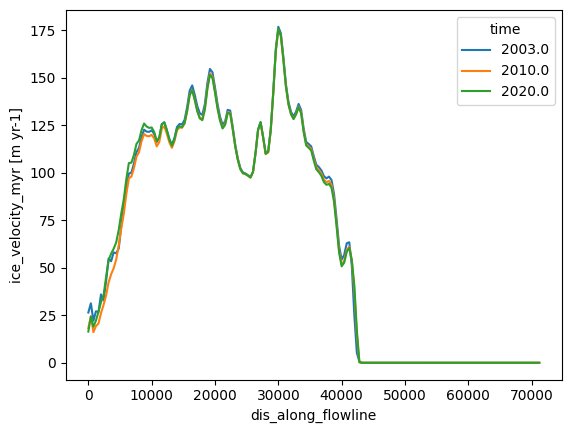
# The OGGM model flowlines also have the downstream lines
df_regular['OGGM_velocity_run_begin'] = ds_fl.sel(time=2003).ice_velocity_myr.data[:len(df_regular)]
df_regular['OGGM_velocity_run_end'] = ds_fl.sel(time=2020).ice_velocity_myr.data[:len(df_regular)]
---------------------------------------------------------------------------
NameError Traceback (most recent call last)
Cell In[54], line 2
1 # The OGGM model flowlines also have the downstream lines
----> 2 df_regular['OGGM_velocity_run_begin'] = ds_fl.sel(time=2003).ice_velocity_myr.data[:len(df_regular)]
3 df_regular['OGGM_velocity_run_end'] = ds_fl.sel(time=2020).ice_velocity_myr.data[:len(df_regular)]
NameError: name 'df_regular' is not defined
df_regular[['obs_velocity', 'OGGM_inversion_velocity',
'OGGM_velocity_run_begin', 'OGGM_velocity_run_end']].plot();
---------------------------------------------------------------------------
NameError Traceback (most recent call last)
Cell In[55], line 1
----> 1 df_regular[['obs_velocity', 'OGGM_inversion_velocity',
2 'OGGM_velocity_run_begin', 'OGGM_velocity_run_end']].plot();
NameError: name 'df_regular' is not defined
What’s next?#
return to the OGGM documentation
back to the table of contents


